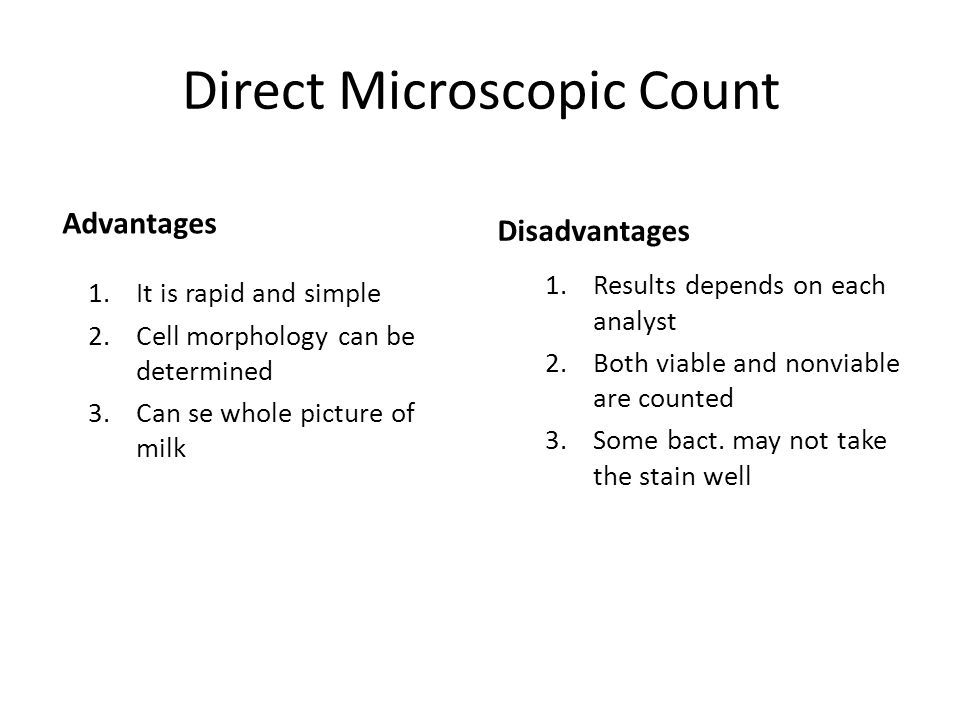As the dilutions progress, you will reach a point where a reasonable number of colonies can be counted and multiplied by the dilution factor to get concentration. Disadvantages- does not separate bacteria like a streak plate and you have to work with liquid agar.
Here's a paragraph about the molds that may help to infer the reason of the advantages during observation of mold colonies: 'Because the structural components of molds are very delicate, even simple handling with an inoculating loop may result in mechanical disruption of their components.The followi ng culture technique es used to to avoid this disruption. After culturing, molds spores are deposited in the surface of the agar and incubated in a moist chamber at room temperature. Direct microscopic observation is then possible without fear of disruption or damage to the anatomical components'. It may be more beneficial in this aspect: allowing a full and healthy growth of the mold, that is, with its complete structure, then to be able to proceed to look through the microscope maybe it form, type of spore,sporangia or mycelium. In short, ensure that the mold to grow properly. Maybe it's not what you exactly were looking for but it could help you! Second Year of Microbiology bachelor's degree (University Of Puerto Rico in Arecibo) Paragraph taken of Capuccino/Sherman Microbiology.
A laboratory Manual.Eight Edition. The following are some advantages of an agar plate verses a slant tube: 1. Surface area- An agar plate has a much larger surface area: a. Easier to isolate individual colonies using the streak-plate method. Evaluate the colony shape, margin and elevation. Can grow a larger number of ce lls. Growth- An agar plate allows you to quantify the number of colonies on an agar plate, provided it is within the 30-300 range.
Whereas the slant tube cannot quantify growth but only describes growth as none, slight, moderate, or large.
Abstract An important task of the clinical microbiology laboratory is the performance of antimicrobial susceptibility testing of significant bacterial isolates. The goals of testing are to detect possible drug resistance in common pathogens and to assure susceptibility to drugs of choice for particular infections. The most widely used testing methods include broth microdilution or rapid automated instrument methods that use commercially marketed materials and devices.

Manual methods that provide flexibility and possible cost savings include the disk diffusion and gradient diffusion methods. Each method has strengths and weaknesses, including organisms that may be accurately tested by the method.
Game java rpg china 240x320 java. Nice graphics and addictive gameplay will keep you entertained for a very long time. Page Information: Download King Of Fighters 240x320 China game for mobiles - one of the best Java games! At PHONEKY Free Java Games Market, you can download mobile games for any phone absolutely free of charge.
Some methods provide quantitative results (eg, minimum inhibitory concentration), and all provide qualitative assessments using the categories susceptible, intermediate, or resistant. In general, current testing methods provide accurate detection of common antimicrobial resistance mechanisms. However, newer or emerging mechanisms of resistance require constant vigilance regarding the ability of each test method to accurately detect resistance. Emergence of Antimicrobial Resistance and the Rationale for Performing Susceptibility Testing The performance of antimicrobial susceptibility testing by the clinical microbiology laboratory is important to confirm susceptibility to chosen empirical antimicrobial agents, or to detect resistance in individual bacterial isolates. Empirical therapy continues to be effective for some bacterial pathogens because resistance mechanisms have not been observed e.g., continued penicillin susceptibility of Streptococcus pyogenes. Susceptibility testing of individual isolates is important with species that may possess acquired resistance mechanisms (eg, members of the Enterobacteriaceae, Pseudomonas species, Staphylococcus species, Enterococcus species, and Streptococcus pneumoniae ).
Overview of Commonly Used Susceptibility Testing Methods Broth dilution tests. One of the earliest antimicrobial susceptibility testing methods was the macrobroth or tube-dilution method [].